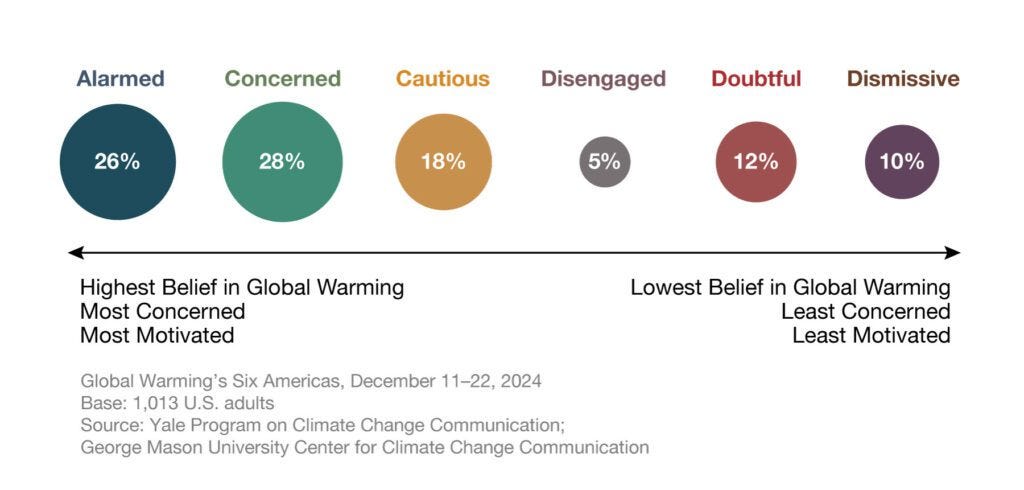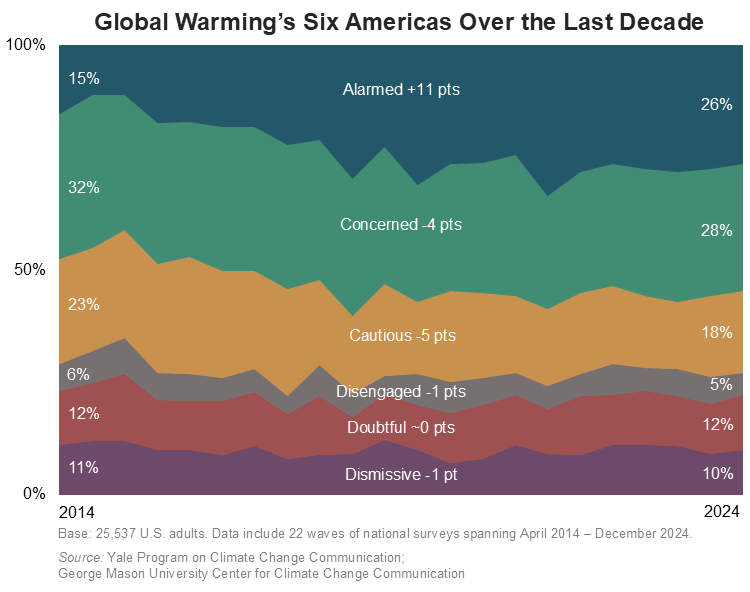Refugia Newsletter #89
EPA threatened, surprising coalitions on clean energy, biodiversity summit good news, refugia farmers, monarchs, and mesmerizing tree bark
Refugia News
What did I help build today? That’s the question I’ve been asking myself this week. Amid all the senseless chain-sawing and smashing of the US federal government, amid the division of Americans into separate realities, amid the rancor and retrogression in some elements of the American church—what are we building from within this mess toward a better world?
I’ve been thinking about Chapter 1 of Refugia Faith, titled “From Despair to Preparation.” In that chapter, I made the case that, in the Bible, places of bewilderment and desperation and destruction are also, simultaneously, places where God prepares people for the divine making-of-all-things-new: “In the wilderness, prepare the way”—and we see that happening in many scriptural stories. This despair-to-preparation thing sounded so great at the time. Now I’m mad that it all feels so pertinent.
Well, I believe God does this work at least partly through people, in ways far beyond the sum of our efforts. Our role is lean into that healing work with all our heart, mind, soul, and strength, out of love for God, neighbor, and this whole creation. So I’ve been trying to deal with the anxieties of this moment by remaining involved with groups that are building things: forming coalitions, strengthening local community, making interfaith connections, working directly and effectively toward a more just and sustainable world. I hope you are finding ways to do that as well. Persevering in building the world we long for is the most effective act of resistance to destruction and hate.
Speaking of Refugia Faith, I thought I would just quickly mention that we have passed the three-year anniversary of the book release with Fortress Press in February of 2022. Hooray! I’m so grateful the book continues to find readers and prove meaningful. Thank you to all who have been passing the book along to others.
Shout out today to the good folks at Pepperdine University in Malibu, California, who hosted me last week for the W. David Baird Distinguished Lecture Series. I got to speak to a great audience of students, faculty, staff, and community members in the “surfboard room.” Not even kidding. The room was lined with a collection of antique surfboards. While on campus, I learned a lot about how folks endured the Franklin and Palisades fires, and it was sobering to bear witness both to their personal scars and to the burn scars still visible in Malibu Canyon and on the Pacific Coast Highway (which is still barely passable around Malibu—someone showed me videos). Much gratitude for the kind hospitality of my hosts.
Shout out also to Mark Lagerway for bringing at least three new subscribers to this Substack. Mark describes himself as a “Michigan folk singer-songwriter, climate advocacy retiree, Third Actor helping establish a new podcast and Youtube Vodcast Cool Tunes for a Hot Planet.” Check out his website. Thanks, Mark!
What are we building? Through the cold and dark of winter, this young burr oak held onto last year’s bird’s nest. I wonder if someone will nest here this spring?
This Week in Climate News
Hmm, so which of the federal agencies now being gutted shall I focus on? How about the EPA. The Environmental Protection Agency was founded under Nixon (!) in 1970 because people made clear they do not enjoy polluted air, toxic water, or burning rivers. At the time, citizens and their Congressional reps recognized that we need regulations to rein in practices that pollute and destroy the environment.
We are having a backsliding moment today, as Oliver Milman and Dharna Noor report in The Guardian:
Last week, Trump’s Environmental Protection Agency (EPA) provoked uproar by unveiling a list of 31 regulations it will scale back or eliminate, including rules limiting harmful air pollution from cars and power plants; restrictions on the emission of mercury, a neurotoxin; and clean water protections for rivers and streams.
Lee Zeldin, the EPA’s administrator, called the extraordinary series of rollbacks the “greatest day of deregulation our nation has seen” and declared it a “dagger straight into the heart of the climate change religion”. One of the most consequential actions will see the EPA reconsider a landmark 2009 finding that greenhouse gases harm human health, which has been used to underpin laws aimed at addressing the climate crisis.
Climate change religion? Yeah, I’ve heard that one before. Sorry, but we Americans are far more in danger of worshiping money in this country than worshiping trees and rivers. Speaking of money, this proposed rollback is all being justified by the usual claim that eliminating regulations will “lower consumer costs”:
Trump’s EPA has said its immolation of environmental protections will “roll back trillions in regulatory costs and hidden ‘taxes’ on US families”. However, the agency’s own analyses shows that the regulations save the US economy far more money than it costs businesses to implement new pollution controls, by a factor of around six to one.
Imagining that allowing more pollution and toxic waste will “lower consumer costs” assumes that good-hearted businesses will pass along their “regulation savings” to consumers. Really? We’re supposed to believe that will happen? Even if it did, we would still pay in other ways.
Pollution always has costs in public health and environmental destruction. “De-regulating” simply means those costs are “externalized” from profit sheets and shunted off onto you and me, one way or another. It’s just a matter of who benefits and who pays.
“The costs of these regulations are a fraction of their benefits,” said Jeremy Symons, a former EPA staffer, now senior adviser to the Environmental Protection Network (EPN), a group made up of former EPA employees.
“For every million dollars of favors that Trump’s EPA is handing out to corporate polluters, the public suffers $6m in public health costs through asthma attacks, cancers and heart and lung disease. That’s a great deal for the wealthy corporate polluters who backed Trump but it’s a bad deal for anyone else who breathes.”
Feel free to call your reps to protest these potential rollbacks. And help people understand that no one wants pollution! And also, these regulations save costs and lives.
Thankfully, over the past ten years, more and more Americans understand that climate change has health impacts. This article by Keerti Gopal for Inside Climate News reports on a recent survey by the excellent Yale Program on Climate Change Communication and George Mason University’s Center for Climate Change Communication. Gopal writes:
The report found that 39 percent of the country believes that global warming is harming Americans’ health “a great deal” or “a moderate amount,” an 8 percent increase since a previous survey in 2014. Nearly half of Americans also understand that climate-related health harms impact Americans unequally, a 13 point increase.
The survey also found increasing knowledge about specific health harms from climate change: 37 percent of Americans were able to identify at least one specific climate-related danger— including respiratory problems, extreme heat, pollution and extreme weather events. That’s a 5 percent increase from 2014.
And a growing share of Americans believe that harms like heat stroke, asthma and lung disease, bodily harm from extreme weather and hunger will be more common in their community over the next 10 years if nothing is done to address global warming.
As the study’s lead investigator remarked, the survey’s “results are fundamentally irreconcilable with the actions of the Trump administration.”
Curious, I went to the Yale program’s website to see the latest data for their “Six Americas Survey.” They’ve been doing this research since 2009, surveying Americans to understand how they feel about climate change. You can take the quiz yourself! It’s fun! (Well, it’s easy anyway.) Here are the latest results from their professional survey process, as of last fall:
Interesting. A majority of Americans are “alarmed” or “concerned” about climate change. In fact, the report summary observes, “Overall, Americans are more than twice as likely to be Alarmed or Concerned than Doubtful or Dismissive (22%).”
The proportion of alarmed/concerned, moreover, has been increasing over the past decade, with people shifting toward “alarmed.” Meanwhile, the proportion of doubtful/dismissive has remained about the same. So. Please understand that the climate doubters and deniers now getting so much news are not even close to the majority of Americans.
Let’s balance the EPA story with a piece of good news. I didn’t report anything about the COP16 UN Biodiversity Summit last November in Cali, Colombia, because the thing ended in frustration, without specific commitments going forward on how to fund biodiversity initiatives. Amazingly, the conference parties decided to get together again for two more days in Rome, February 26-27. They reached an agreement! This article by Steven Grattan and Sibi Arasu for AP reports:
The countries agreed on how they would contribute $200 billion a year by 2030 that was committed in principle at an earlier meeting in Montreal. The money includes a plan to raise $20 billion in annual conservation financing for developing nations by 2025, with that number rising to $30 billion annually by 2030, and on details of the Global Biodiversity Framework, which aims at placing 30% of the planet and 30% of degraded ecosystems under protection by 2030.
Earlier this week, the countries also agreed to create the Cali Fund, which will create methods for industries that commercially benefit from biodiversity to contribute to its conservation.
That last bit is super interesting: it means that the new agreement includes a “landmark deal requiring companies that profit from natural genetic resources, such as developing medicines from rainforest plants, to share those benefits.”
Linda Krueger of the Nature Conservancy observed: “At a complicated geopolitical moment, this is an exciting show of progress and international cooperation for nature.” The clear goals and accountability measures are a major accomplishment.
Deeper Dive
I’ve written before about the importance of defending IRA incentives for clean energy transition. I’ve also mentioned how these incentives have been benefitting red districts, prompting Republican members of Congress to … defend the IRA? Well, sort of. The New York Times this week published several articles about the push in Congress to rally Republicans around preserving clean energy tax cuts. David Gelles interviewed Representative Andrew Garbino, R-NY, who is taking the lead in these efforts, preparing a letter signed by 21 Republicans to the chair of the Ways and Means Committee. In order to preserve benefits to their districts, Republicans are trying to explain to the president and their fellow Republicans that clean energy is crucial to the goal of “energy dominance”:
“The president wants us to be an energy dominant country, and solar and wind has to be part of that discussion,” he said. “It takes 10 years to build a natural gas plant. We don’t have the technology right now for nuclear or geothermal to work on a large scale. We need energy now, and solar and wind are the quickest things to get online.”
Will Garbarino’s persuasion campaign work? He thinks so, at least in part.
“I don’t think we’re going to end up seeing a full repeal,” he said. “Could there be changes? Absolutely. That’s up for negotiation. But I think this letter shows that there is enough support that full repeal would be too painful.”
Garbino is responding not only to constituent concerns but to a major lobbying effort from the clean tech industry. In another article, Gelles explains:
In February, the Solar Energy Industries Association, a trade group, organized a lobbying day in Washington, bringing representatives from more than 160 energy companies to town.
After hosting a breakfast at the Capitol Hill Club, a social club for Republicans, the renewable industry advocates fanned out to congressional buildings wearing stickers that read “American Energy Dominance” and featured an image of solar panels.
Over the course of the day, the solar group and its allies met with staff from more than 60 congressional offices, including 10 members of Congress, and delivered letters supporting the tax credits that were signed by more than 1,850 companies.
Another to-do suggestion for all of us: Call our reps and tell them you definitely want the IRA incentives to stay put.
Interestingly, some of this “odd bedfellow” business is playing out locally. Jake Bolster of Inside Climate News reports that, in Wyoming, a coalition of environmentalists, ranchers, small businesses, and municipal governments together tried to pass a bill in the state house “that would have steeply increased the amount of rooftop solar that schools, municipal buildings and businesses could install on their property.” The bill’s sponsor was Scott Heiner, a member of… the Freedom Caucus.
Wyoming conservatives, as in other Western states, find solar appealing because having solar panels on their properties and businesses lowers their costs and allows for energy autonomy. It’s about self-reliance. They want to build solar for “freedom” reasons, not climate reasons. But they still want to build solar.
The bill passed nearly unanimously in the Wyoming house but failed in the senate by one vote, over net-metering tussles. Heiner plans to try again in two years.
Image: WeDoSolar/pv-magazine-usa.com
Meanwhile, a bill just passed almost unanimously in Utah (awaiting governor’s signature) to allow people to install “balcony solar.” This is strictly to use the energy generated directly—no connection to the utility. It’s a big deal, except there’s some doubt right now whether any available panel systems meet the applied safety standards. Well, that could change. Both these stories indicate that local efforts can build coalitions and create meaningful action.
To-do list: keep working locally toward clean energy transition. We all have more power locally than we think!
A second deep dive today on rhetoric. If you’re concerned about public discourse, particularly about the ways that false ideas get spread and people are subtly influenced by rhetoric, take a look at this fascinating piece by Antonia Scattan on the Reframing America Substack.
The idea is that well-meaning people, in an attempt to disclaim false things, end up repeating the rhetoric in such a way that they end up spreading the false ideas anyway. It has to do with the way our brains process word associations more readily than the actual syntax or logic of a sentence. So the trick is to be careful about which words you associate with what—which words you put near other words. It’s kind of hard to explain, so if you’re interested, please click through.
OK, and here’s a link that manages to combine ALL the stories in this newsletter so far today! Current and former staffers at the EPA just released this open letter to the public, explaining how IRA funds used for the EPA’s environmental justice initiatives are being improperly rescinded, at the expense of taxpayers. I think the rhetoric used in the letter follows Scattan guidelines pretty well. There are tips for action at the end, too. See what you think.
Refugia Sightings
When I was a kid, we saw monarch butterflies in the summer constantly. They were as common as robins. Now, I hardly see them at all. So I am glad to see two pieces of good news about monarchs this week.
First, an article by Fabiola Sanchez in AP reports that experts have noticed monarchs covering more area in their winter habitat west of Mexico City. The number of monarchs seems to have “rebounded this year, doubling the area they covered in 2024 despite the stresses of climate change and habitat loss.” These are monarchs who spend their summers east of the Rockies in the US and Canada. (The western monarchs are far more endangered.)
The rebound for the eastern monarchs seems to be down to relief from last year’s drought:
The impact of changes in weather year after year mean fluctuations are expected. For that, Jorge Rickards, Mexico director general for the World Wildlife Fund, said “you can’t let down your guard” and must continue to expand conservation efforts.
Tavera Alonso credited ongoing efforts to increase the number of plants the butterflies rely on for sustenance and reproduction along their flyway.
Now let’s zoom in for further detail on some of those conservation efforts. Sam Matey did a great in-depth interview with a Mexican ecologist who is basically using refugia conservation biology methods to help ensure monarchs have their favorite fir trees to hang out on for years to come:
Dr. Cuauhtémoc Sáenz-Romero is an ecologist and forester, a professor at the Universidad Michoacana de San Nicolás de Hidalgo in Mexico. He’s leading a pioneering climate resilience conservation project: planting oyamel firs (Abies religiosa, aka “sacred firs”) at higher elevations than historically found to ensure consistent overwintering habitat for monarch butterflies as the world warms. They’re essentially “relocating a forest,” planting oyamel fir seedlings to create a new forest high on the slopes of dormant volcano Nevado de Toluca near Mexico City.
Fun note: Abies religiosa are so named because branches from the tree are used in Christmas and other festivals in Mexico. Anyway, Dr. Sáenz-Romero figured out using climate modeling that “the suitable climatic habitat for Abies religiosa may no longer occur in the Monarch Butterfly Biosphere Reserve by end of the century.” So he and his team are effectively helping a forest move to a higher elevation, where temperatures will be cooler.
This involves not only collecting seeds and nursing seedlings of the firs, but also of companion or nurse shrubs that help the firs survive. None of this has been easy—rough conditions, much trial and error—but they are now seeing firs establish well in higher elevations when planted with their companion plant friends.
Will the monarchs figure out they have to adjust their GPS systems to find their shelter trees? It seems so—they are already moving nearer to the places where Dr. Sáenz-Romero’s team is planting their future homes. This is all the more amazing as it takes several generations for monarchs to complete their migration cycle: the individuals who return are not the same ones who left Mexico the year before.
Planting oyamel seedlings under the shade of pre-existing shrubs (Senecio cinerarioides) at 3,800 m of elevation at Nevado de Toluca. Image and caption credit: Sam Matey.
Let’s end with a beautiful, inspiring, hopeful video. You will be glad, I promise, if you take 30 minutes to watch this video about the work of Flo Reed and Sustainable Harvest International, a group that assists smallholder farms in Central America to adopt regenerative farming. All over the world, including in Central America, industrial agriculture has degraded land, created food insecurity, and contributed to climate change. But some smallholder farmers are reversing these problems for their communities with regenerative methods tailored to their particular land.
The potential to scale up is addressed, too. At one point, Reed remarks, “If all 500 million smallholder farmers around the world, the farmers just growing on a few acres, if they all used these ecological farming practices, they could get us 54% of the way to the United Nations’ goals for net greenhouse gas reductions.” Wowza.
Moment of Wonder
I’ll end by sharing some photos I took on Pepperdine’s beautiful campus. I could not get enough of these eucalyptus trees. I found the textures mesmerizing!
Thanks for reading. Till next time, find strength, get rest, and be well.
As always, bold text in quotations is added.












Thank you, Debra, for the prompt to reflect on what we are building. This question is especially important, in our time where the social fabric is unraveling, and the tapestry that binds us to one another, has more dangling threads by the day. This is especially true for our neighbors who live on the margins.
I live in Maine, America's "whitest state" but one with a large percentage of refugees and asylum seekers.
In my job as a community bus driver, I encounter people who have moved here from Central America, the Middle East and Eastern Europe. Most have come fleeing violence and hoping for welcome. Too often they encounter the opposite, sometimes the comments are subtle, sometimes overt.
I have tried to learn a few words of grace, in the languages of my various passengers. I start with hello, good-bye, thank you and you're welcome.
Yesterday, I picked up a middle-aged Muslim woman and her two teenage daughters. As they boarded my van, I introduced myself and commented on the rainy weather. The mother gave me what seemed like a stern look and said, "No English, Arabic." I nodded and we sat in silence for the 30 minute drive.
As we arrived the girls got out from the back seat, and said "thank you" in English. I responded, with "afwan" -- you're welcome Arabic. They smiled and said, "shukran" - thank you in their native tongue. I then said, "masalam", an Arabic parting meaning "go in peace".
The mother who was walking ahead of us, turned quickly, and with a big smile on her face, said, "Arabic! Shukram, thank you."
It was a simple exchange but one that I think built something. It was a small something, but a foundation upon which more can be built during future trips. In a world where my new friends are often told they need to speak English and become like us, my little effort to meet them in their language and express curiosity about their lives, created a different possibility than the one filling our newspapers and phone screens.
Masalam,
Scott Klinger
Gardiner, Maine